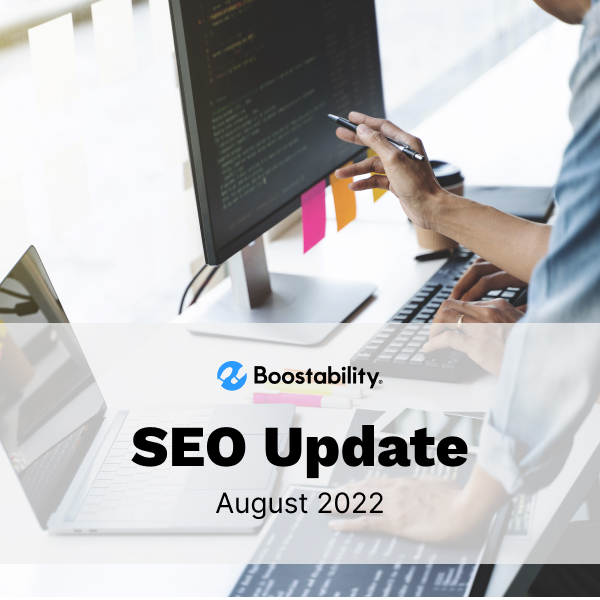
As the end to summer begins to approach, Google is ramping up its changes, clarifications, announcements, and updates to start off the fall with a bang. There’s never a dull moment when it comes to keeping up with SEO news. This month’s SEO update is going to focus on several aspects of two big changes announced from Google. So let’s dive in first with one of the bigger items to hit Google News so far this year.
Google’s Helpful Content Update
Halfway through the month of August, Google announced it would start to roll out what they’re calling the “Helpful Content Update”. That update started to roll out at the end of the month, and should take several weeks to roll out completely. The goal behind the Helpful Content Update is to help users see more original and helpful content written by people, for people in their search results. Meaning, Google is cracking down on AI written content by SEOs trying to cheat the system with articles written only to try and rank, not improve the user experience or to inform people.
Next week, we will launch the “helpful content update” to better ensure people see more original, helpful content written by people, for people, rather than content made primarily for search engine traffic. Learn more & advice creators should consider: https://t.co/fgf2TPNIqD pic.twitter.com/xOuX2iVk2d
— Google Search Central (@googlesearchc) August 18, 2022
Of course you still need to write articles and content with best SEO practices in mind, meaning it’s important to include high ranking keywords, good meta descriptions, and with content clustering for your articles. But you want to make your posts informative, helpful, and with good writing practices. That is what Google will use to determine if a piece of content is high-quality or not. The more high quality articles, the better chance of your site ranking higher as a whole.
Google says “removing unhelpful content could help the rankings of your other content”. So it goes beyond having good articles, but also removing any bad content, or pieces that are shorter, fewer keywords, poorly written, or doesn’t provide value to the reader. A good way to fix this issue is to set up redirects to more purposeful content that has greater value.
What is helpful content?
When creating content for your website, think of the types of content that you want to read. You want articles on topics that are thoroughly researched. And you also want to feel like you’re reading from an authoritative source, not just a casual blogger. Google offers guidelines and questions that can help you as a writer to create content with a “people-first” approach. Some of these questions include:
- Does your content clearly demonstrate first-hand expertise and depth of knowledge?
- Does your site have a primary purpose or focus?
- After reading your content, will someone leave feeling they’ve learned enough about a topic to achieve their goal?
Helpful Content Feedback Form
If you feel like your content or website has been unfairly affected by this Helpful Content Update or you see an unexplained drop in rankings, Google has provided a feedback form. They’re asking for the affected page, the query that shows “non-ideal results”, and then your comments. The form says that it will not use the submissions to take direct action and reverse a possible drop in traffic or rankings. But they’ll take the feedback to improve the algorithm and “search results for everyone.”
Quick Read & 5 Minute Read in SERPs
Not directly related to the Helpful Content Update, but in a similar vein, Google has also started to show labels in its search results that can say “Quick Read” or “5 Minute Read” to give searchers a better idea of how long an article is and what it will take to read it. Lily Ray noticed this and posted it on Twitter.
Well that’s fancy (except when every article is less than a 5 minute read 😅)
Is it new @rustybrick? (Sorry if you’re in a tunnel) pic.twitter.com/jYQKN41W2p
— Lily Ray 😏 (@lilyraynyc) August 26, 2022
Google Search Console Updates
August saw a lot of updates to reports and data within Google Search Console. Back in June they sent out a Tweet about how GSC would simplify the way pages are classified. At the time, the change helped SEOs to focus on the critical issues. In August, Google tweeted they’re going to disable task validation of “index coverage issues” temporarily while they migrate all Search Console properties to the updated classification mentioned in June.
We’re preparing to migrate all Search Console properties to the updated item classification in approximately 2 weeks. In order to do it smoothly, we are going to disable task validation of index coverage issues until we finish the migration. Thanks for your understanding. https://t.co/FWHxLcoNfl
— Google Search Central (@googlesearchc) August 1, 2022
What does all that mean? Google says that they’ve had feedback from users saying they’re confused by the warning status on a URL or an item. This means Google is changing up how they label things. “Pages or items with critical issues are labeled something like invalid; pages or items without critical issues are labeled something like valid.” But they reiterate that this change only shows in GSC, not in how Google crawls, indexes, or serves pages to users.
In the middle of the month, Google had to address an additional problem in GSC where it was marking pages as non-indexable when they were, and vice versa. Because of the fix, many people saw drops in the indexed pages in their GSC reports.
Today we fixed a Search Console issue that affected many properties: we were reporting pages that are not indexed as being indexed. As a consequence, you might see a drop in your indexed pages in the Index Coverage report.
— Google Search Central (@googlesearchc) August 17, 2022
